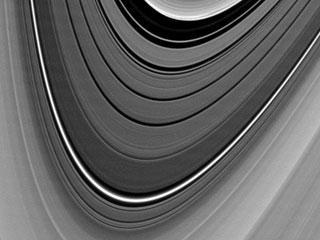
The outer edge of Saturn's B ring exhibits an unexpected feature in this movie made from images captured by Cassini. Photo: NASA
WASHINGTON (BNS): Saturn rings behave like a miniature version of our own Milky Way galaxy and that’s why one of the most dynamic regions in Saturn's rings has such an irregular and varying shape, according to a new NASA study.
NASA's Cassini spacecraft has captured new images of the B ring's outer edge and focus the presence of at least two perturbed regions, including a long arc of narrow, shadow-casting peaks as high as 3.5 kilometers (2 miles) above the ring plane.
The areas are likely populated with small moons that might have migrated across the outer part of the B ring in the past and got trapped in a zone affected by the moon Mimas' gravity. This process is commonly believed to have configured the present-day solar system.
"We have found what we hoped we'd find when we set out on this journey with Cassini nearly 13 years ago: visibility`y into the mechanisms that have sculpted not only Saturn's rings, but celestial disks of a far grander scale, from solar systems, like our own, all the way to the giant spiral galaxies," Carolyn Porco, co-author on the new paper and Cassini imaging team lead, based at the Space Science Institute, Boulder, Colorado, said.
The outer B ring's behavior was always known for its complexity.
Now, analysis of thousands of Cassini images of the B ring taken over a four-year period has revealed the source of most of the complexity: at least three additional, independently rotating wave patterns, or oscillations that distort the B ring's edge.
These oscillations, with one, two or three lobes, are not created by any moons. They have instead spontaneously arisen, in part because the ring is dense enough and the B ring edge is sharp enough, for waves to grow on their own and then reflect at the edge.
The new observations confirm the first large-scale wave oscillations of this type in a broad disk of material anywhere in nature.
Self-excited waves on small, 100-meter (300-foot) scales have been previously observed by Cassini instruments in a few dense ring regions and have been attributed to a process called "viscous overstability."
The two perturbed B ring regions found orbiting within Mimas' zone of influence stretch along arcs up to 20,000 kilometers (12,000 miles) long. The longest one was first seen last year when the sun's low angle on the ring plane betrayed the existence of a series of tall structures through their long, spiky shadows.
The small moons disturbing the material are probably hundreds of meters to possibly a kilometer or more in size.
 Previous Article
Previous Article Next Article
Next Article











The Indian Air Force, in its flight trials evaluation report submitted before the Defence Ministry l..
view articleAn insight into the Medium Multi-Role Combat Aircraft competition...
view articleSky enthusiasts can now spot the International Space Station (ISS) commanded by Indian-American astr..
view article